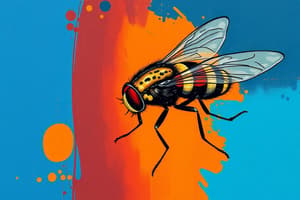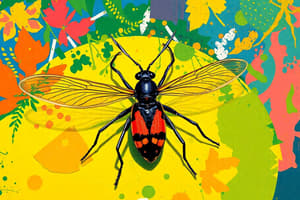Podcast
Questions and Answers
What is the primary reason for pest management?
What is the primary reason for pest management?
- To eliminate all pests from the environment
- To maintain a clean and disease-free environment (correct)
- To promote the growth of pests in a controlled manner
- To reduce the economic impact of pests on agriculture
Which of the following is NOT a method of natural control?
Which of the following is NOT a method of natural control?
- Genetic modification of crops
- Pesticide application (correct)
- Soil tillage
- Trap crops
What is the main goal of cultural control?
What is the main goal of cultural control?
- To make the crop environment unsuitable for pests (correct)
- To eliminate pests completely
- To increase crop yield
- To reduce the growth of pests
What is the primary function of a trap crop?
What is the primary function of a trap crop?
Which of the following is an example of biological control?
Which of the following is an example of biological control?
What is the definition of a pest?
What is the definition of a pest?
What is the goal of eradication in pest management?
What is the goal of eradication in pest management?
What is the purpose of clean culture in natural control?
What is the purpose of clean culture in natural control?
What is the primary mode of action of pyrethroid insecticides?
What is the primary mode of action of pyrethroid insecticides?
What is the primary goal of genetic control in pest management?
What is the primary goal of genetic control in pest management?
What is a characteristic of pyrethrins and pyrethrum?
What is a characteristic of pyrethrins and pyrethrum?
Which of the following is an example of a biological insecticide?
Which of the following is an example of a biological insecticide?
What is the technique of mass rearing, sterilizing, and releasing insects to reduce wild populations known as?
What is the technique of mass rearing, sterilizing, and releasing insects to reduce wild populations known as?
Who is credited with first describing the Sterile Insect Technique (SIT) in 1955?
Who is credited with first describing the Sterile Insect Technique (SIT) in 1955?
What is the term for the way in which a pesticide kills or inactivates a pest?
What is the term for the way in which a pesticide kills or inactivates a pest?
Which of the following insecticides affect the nervous system?
Which of the following insecticides affect the nervous system?
What is the advantage of the Sterile Insect Technique (SIT) in pest management?
What is the advantage of the Sterile Insect Technique (SIT) in pest management?
Which of the following pest species was eradicated from the United States using the Sterile Insect Technique (SIT)?
Which of the following pest species was eradicated from the United States using the Sterile Insect Technique (SIT)?
What is a common use of pyrethrins and pyrethrum?
What is a common use of pyrethrins and pyrethrum?
What is the primary mechanism of action of the Sterile Insect Technique (SIT) in reducing wild populations?
What is the primary mechanism of action of the Sterile Insect Technique (SIT) in reducing wild populations?
What is a characteristic of organophosphates?
What is a characteristic of organophosphates?
Which of the following is NOT a success story of the Sterile Insect Technique (SIT)?
Which of the following is NOT a success story of the Sterile Insect Technique (SIT)?
What is a limitation of understanding the mode of action of newer insecticides?
What is a limitation of understanding the mode of action of newer insecticides?
What is the purpose of sterilizing the insects in the Sterile Insect Technique (SIT)?
What is the purpose of sterilizing the insects in the Sterile Insect Technique (SIT)?
What is the primary mechanism by which chlorinated hydrocarbons, such as methoxychlor and dicofol, affect nerve cells?
What is the primary mechanism by which chlorinated hydrocarbons, such as methoxychlor and dicofol, affect nerve cells?
What is the mode of action of microbial insecticides?
What is the mode of action of microbial insecticides?
What is the primary mechanism of action of fungal insecticides?
What is the primary mechanism of action of fungal insecticides?
What is the mode of action of insecticidal soaps?
What is the mode of action of insecticidal soaps?
What is the primary mechanism of action of oil-based insecticides?
What is the primary mechanism of action of oil-based insecticides?
What is the key difference between contact and stomach insecticides?
What is the key difference between contact and stomach insecticides?
How do respiratory insecticides affect insects?
How do respiratory insecticides affect insects?
Which of the following insecticides works by inhibiting the movement of potassium and sodium ions across nerve cell surfaces?
Which of the following insecticides works by inhibiting the movement of potassium and sodium ions across nerve cell surfaces?
What is the role of viruses in microbial insecticides?
What is the role of viruses in microbial insecticides?
Which of the following insecticides is applied directly to the insect's body?
Which of the following insecticides is applied directly to the insect's body?
What is the primary goal of SIT as a PM tactic?
What is the primary goal of SIT as a PM tactic?
What is a geographical limitation of using SIT?
What is a geographical limitation of using SIT?
Why is the release of lab-reared males in SIT dependent on the timing of the wild population?
Why is the release of lab-reared males in SIT dependent on the timing of the wild population?
What is the purpose of inherited/delayed sterility in SIT?
What is the purpose of inherited/delayed sterility in SIT?
What is a potential problem with the use of lab-reared males in SIT?
What is a potential problem with the use of lab-reared males in SIT?
What is a limitation of SIT in terms of knowledge about the pest?
What is a limitation of SIT in terms of knowledge about the pest?
What is a potential problem with the use of radiation in SIT?
What is a potential problem with the use of radiation in SIT?
What is an advantage of inherited/delayed sterility compared to traditional SIT?
What is an advantage of inherited/delayed sterility compared to traditional SIT?
Flashcards are hidden until you start studying
Study Notes
Pest Control
- A pest is any living organism that causes damage or discomfort, or transmits or produces disease, and spreads diseases to mankind and harms the environment.
- The three goals of pest management are prevention, suppression, and eradication, aiming for a clean environment and disease-free environment.
Natural Control
- Natural control enhances naturally occurring pest management methods.
- Cultural control makes the crop environment unsuitable for pests to feed, live, or reproduce, and includes methods such as soil tillage, crop rotation, harvest or planting date adjustment, irrigation schemes, variety selection, clean culture, and trap crops.
- Clean culture removes breeding sites or the habitat of the pest, and trap crops attract pests to a localized area where the trap crop is destroyed or treated with a pesticide.
Genetic Control
- Genetic control introduces genetic abnormalities into the eggs of the wild population, exploiting the insect's mating expertise.
- The Sterile Insect Technique (SIT) involves mass rearing of the target insect species (males), sterilizing them with ionizing radiation or chemosterilants, and releasing them in large numbers to reduce the probability of successful matings in the wild population.
- SIT was first described by E.F. Knipling in 1955 and has been successfully used to eradicate screwworm flies, Mexican fruit flies, tsetse flies, and sweet potato weevils from various regions.
Advantages of SIT
- Creates inverse density-dependent feedback, making it more efficient as the wild population decreases.
Insecticides
- Pyrethroid insecticides kill insects by disrupting their nervous systems and are non-persistent and less acutely toxic than organophosphates and carbamates.
- Biological insecticides include plant toxins (e.g., caffeine, nicotine, pyrethrum, and rotenone) and bacterial diseases (e.g., Bacillus thuringiensis), which are environmentally friendly.
Types of Insecticides
- Organophosphates (e.g., Chlorpyrifos, diazinon, and malathion) interfere with the transmission of nerve impulses.
- Chlorinated hydrocarbons (e.g., methoxychlor and dicofol) interfere with the normal movement of potassium and sodium ions across nerve cell surfaces.
- Microbial insecticides consist of microorganisms that attack insects, such as Bacillus thuringiensis.
- Fungal insecticides attack from the outside, growing through the cuticle and exoskeleton, and spreading throughout the body.
- Insecticidal soaps (e.g., potassium salts of fatty acids) dissolve nearby cells, causing cell fluids to leak out and resulting in dehydration and death.
- Oils are used to smother mites, scale insects, and aphid eggs.
Limitations of SIT
- Geography: requires natural barriers or defensible borders to prevent the immigration of the target pest from outside the eradication zone.
- Economics: high cost of rearing, sterilizing, and releasing a large number of insects needs to be justified.
- Desirability of sterile males: lab-reared and sterilized males must be equally or more competitive than native males in mating with native females.
- Knowledge about the pest: reproductive behavior, population dynamics, dispersal, and ecology of the insect are crucial for SIT.
- Timing: development of the lab-reared colony must be synchronous with that of the wild population.
- Resistance: native females may recognize and refuse to mate with sterile males.
- Inherited/delayed sterility: an alternative genetic strategy to SIT, requiring fewer insects and lower doses of radiation.
Studying That Suits You
Use AI to generate personalized quizzes and flashcards to suit your learning preferences.




